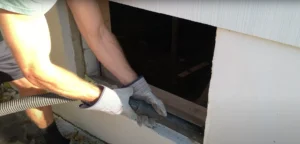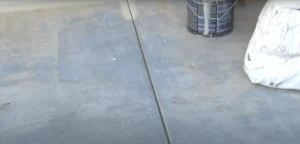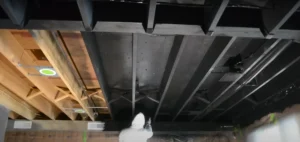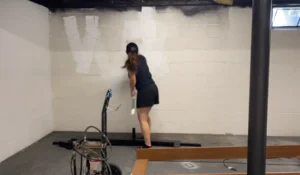Is your basement floor dull and dreary? A fresh coat of paint can make it shine! Many homeowners want to spruce up their concrete basement floors but don’t know where to start. Painting a basement floor can be tricky, but it’s not impossible.
Did you know that epoxy paint can last up to 20 years on a concrete floor? That’s a long-lasting fix for your basement woes. This guide will teach you how to paint a basement floor step by step.
We’ll cover everything from picking the right paint to applying it like a pro, including the best way to paint a garage floor. Get ready to paint a concrete basement floor with the right tools and techniques. transform your basement into a space you’ll love!
Key Takeaways
- Clean and prep the basement floor well before painting. This includes sweeping, scrubbing, and fixing cracks.
- Two-part epoxy paint is best for basement floors. It lasts 10-20 years and resists water and stains.
- Apply paint in thin coats using even strokes. Start in a corner and work your way out.
- Let each coat dry for at least 24 hours before adding another. Good airflow helps paint dry faster, especially when using concrete paint.
- A painted basement floor can make the space look better and add value to your home.
Preparing the Basement Floor
Preparing your basement floor is crucial for a successful paint job. Clean and degrease the surface, then address moisture issues and fill any cracks.

Cleaning and Degreasing
Cleaning and degreasing your basement floor is vital for paint to stick well. This step ensures a smooth, long-lasting finish that will make your basement look great.
- Sweep the floor: Use a stiff broom to remove loose dirt and debris.
- Vacuum thoroughly: Pick up fine dust particles with a shop vac.
- Scrub with detergent: Apply heavy-duty detergent to remove stains and grease.
- Rinse clean: Use a mop and clean water to wash away all soap residue.
- Remove old paint: Scrape off any flaking or peeling paint with a putty knife.
- Treat tough stains: Use a wire brush on stubborn marks or oil spots.
- Apply etching solution: This helps new paint bond better to concrete.
- Final rinse: Wash the floor again to remove all cleaning products.
- Dry the floor: Run a dehumidifier or fan to speed up drying time.
- Check for moisture: Ensure the floor is fully dry before painting.
Moisture Control and Crack Filling
After cleaning, focus on moisture control and crack filling. These steps are vital for a long-lasting paint job on your basement floor.
- Check for moisture issues:
- Use a moisture meter to test the concrete floor
- Look for damp spots or water stains on walls and floors
- Install a dehumidifier to reduce moisture levels
- Address water sources:
- Ensure the ground slopes away from your home’s foundation
- Fix any leaky pipes or appliances in the basement
- Seal gaps around windows and doors
- Fill cracks and holes:
- Clean out cracks with a wire brush
- Use a concrete repair compound for small cracks
- Apply epoxy filler for larger cracks or holes
- Allow fillers to dry fully before painting
- Apply a concrete sealer:
- Choose a sealer made for basement floors
- Use a roller or brush to apply an even coat
- Let the sealer dry for 24 hours before painting
- Test for remaining moisture:
- Tape a plastic sheet to the floor
- Wait 24 hours and check for condensation
- If moisture is present, address the issue before painting
Choosing the Right Paint for Your Basement Floor
Picking the best paint for your basement floor matters a lot. Two-part epoxy paint stands out as the top choice. This paint mixes epoxy resin and hardener, creating a tough surface that lasts 10 to 20 years.
Epoxy paint resists water, stains, and wear, making it perfect for basements. You’ll find many colors to pick from, like gray, beige, ivory, green, and shades of blue. Some good brands to look at are Drylok, Rust-Oleum Epoxy Shield, and Kilz.
These paints offer strong protection and come in kits with all you need to coat your floor.
Painting the Basement Floor
Painting your basement floor transforms the space. Start in a corner and work your way out, using even strokes with a roller.

Application Techniques
Start painting from the farthest corner of your basement. Use long, even strokes with a roller or brush to apply the paint. For best results, work in small sections and keep a wet edge.
Apply thin coats rather than one thick layer. This helps the paint dry faster and more evenly. Let each coat dry fully before adding another. Most paints need at least 24 hours between coats, particularly for the second coat.
Don’t forget to wear protective gear like gloves and a mask while painting.
Proper ventilation is key during the painting process. Open windows and use fans to keep air flowing while you apply the paint roller. This helps the paint dry and removes fumes. For epoxy paints, mix the components well before use.
These paints often come in kits with clear instructions. Some floor paints allow you to add decorative chips for extra grip and style. Sprinkle these on while the paint is still wet.
Always follow the maker’s directions for the best outcome.
Conclusion
Painting your basement floor can transform a dull space into a vibrant area. With the right tools and methods, you can create a durable, attractive surface. Proper preparation, selecting high-quality paint, and allowing sufficient drying time are essential steps.
Your newly painted floor will add value and style to your home. Enjoy your refreshed basement space!
FAQs
1. What type of paint should I use for a concrete basement floor?
Use a high-quality concrete floor paint or epoxy floor coating. These are made for concrete surfaces and can handle foot traffic. Latex paint is not the best choice for basement floors.
2. How do I prep my basement floor before painting?
Clean the concrete floor well. Use a vacuum cleaner to remove dust. Wash the floor and let it dry. Sand rough spots. Fill cracks with masonry filler. Apply a primer if needed. Good prep helps the paint stick better, especially when painting an unfinished surface.
3. How long does basement floor paint take to dry?
Most concrete floor paints need 24 hours to dry between coats. Let the final coat dry for at least 24 hours before walking on it. Some paints may need more time. Check the paint can for exact drying times.
4. Can I paint over an already painted basement floor?
Yes, you can paint over a painted floor. Clean it well first to ensure the best results when you paint the floor. Sand the old paint to help the new paint stick. Use a paint that works with the old coating. A primer might help the new paint bond better.
5. How much paint do I need for my basement floor?
Measure your floor’s square footage. Most floor paints cover about 400 square feet per gallon, making them ideal for larger areas like a garage floor. You’ll likely need two coats. So, double the amount. Buy extra to be safe. One floor coating kit often covers about 250 square feet.
6. What safety steps should I take when painting a basement floor?
Open windows for good airflow. Wear a mask to avoid breathing in fumes while using house paint. Use gloves to protect your skin. Wear old clothes and shoes. Keep kids and pets away until the paint dries fully. Follow all safety rules on the paint can.





